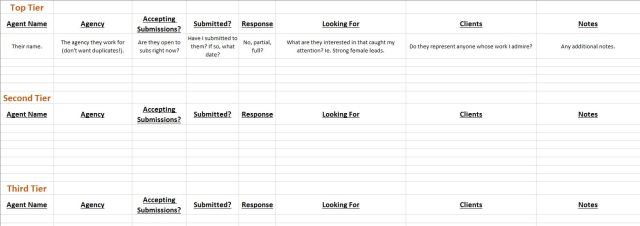Sometimes it feels like your query letter will never be ready, but once it is, you need a strategy for the querying process.

Who should you query? What approach do you take? How do you keep track?
Step 1 – Research and Make a List
There are A LOT of agents out there, and just as many ways to find them. Start by making a list of ones you’re interested in.
Here are a few resources that can help:
- AgentQuery.com
- QueryTracker.net
- Lit Rejections
- Writer's Digest's Guide To Literary Agents
- Agents of authors you like (check the Acknowledgements).
Step 2 – Research (More) and Evaluate
Once you have a list of agents you’re interested in subbing to, it’s important to make sure they’re a good match. Often (not always) you can only submit to one agent per agency, so you want to pick the agent you think is the best fit for you and your work.
What genres does the agent represent? Have they represented books you like? Are they an editorial agent? Are they active on social media?
Some of this stuff is vital – you don’t want to sub to an agent who doesn’t represent your genre – and some of it’s preference. You may not need an editorial agent, or it may be a deal breaker.
Here are some resources to get to know agents:
- Interviews:
- Literary Rambles
- Michelle4Laughs
- Manuscript Wishlist
- Their agency website bios.
- Their personal websites and blogs.
- Their social media pages (Facebook, Twitter, etc).
Step 3 – Get Organized
Now that you know which agents you want to submit to, prepare for your inbox to become a war zone – you’re about to get a lot of emails.

Confirmations, rejections, requests for more material – you need a way to organize it all.
There are a lot of different strategies here – setup folders, hand write a list – but the one that worked well for me was setting up an Excel spreadsheet.
Here’s an idea of what it looked like:

As you can see, I created 3 tiers, which is bit of a misnomer name. Really they were just groups/rounds, which I’ll talk more about below.
Then I kept track of everything from whether I’d already submitted to them to if they represented any clients whose work I loved.
Once I started querying, I only had to fill in the boxes.
Step 4 – Time to Query… Slowly
You know who you want to query, you’re organized and ready to go – now it’s time to query! Just not everyone at once.
Send your query out in batches (what I called tiers above). About 5-10 each round.
Why? Because it lets you test the waters.
Got 10 form rejections in a row? Maybe your query needs some work.
Getting partial requests that are later rejected? Something’s probably not working in the early chapters.
Sending your queries out in batches lets you get feedback from agents and get an idea of what’s working and what’s not.
And with that, I leave you with one final, absolutely vital piece of advice:
Always, always, always follow the agency guidelines.
Check the agency website, make sure you’re following the guidelines for the specific agent you’ve chosen (they differ from the agency as a whole sometimes!) and triple check you’ve followed them before you click send.
You’ve worked hard on your book; you don’t want an automatic pass because of a simple querying mistake.
Good luck!









